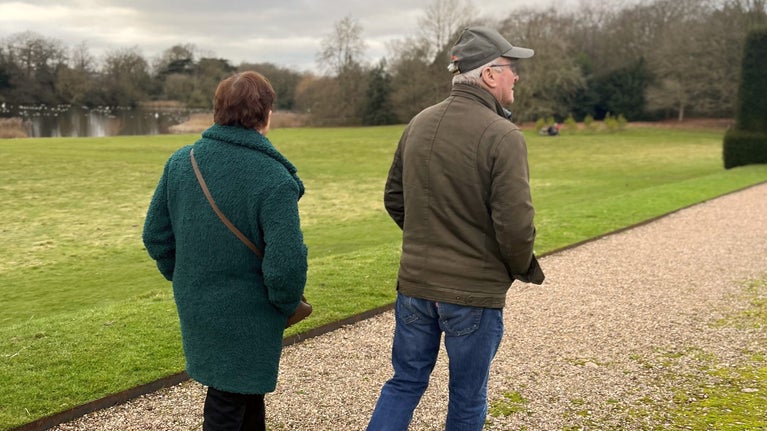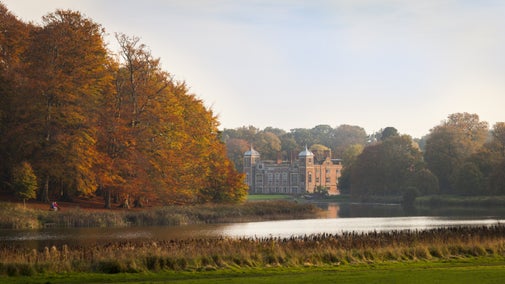
Discover more at The Children's Country House
Find out when The Children's Country House is open, how to get here, the things to see and do and more.

The house and collections team work hard to care for the beautiful interiors and historic artwork that make up Sudbury Hall. It’s no small task; along with regular surveys and conservation cleaning the team must address everything from bugs to the management of light.
A lot of what we do is based on cutting edge conservation science. We have studies of how dust falls in a room, computerised humidity monitoring, integrated pest management systems and comprehensive light planning based on the latest research.
More is being developed every day, yet so much of what we do is still based on the housekeeping tasks that have been in use for centuries.
In the side hall, the stone steps have become porous over years and require regular scrubbing by hand to keep them clean. We now put a coat of micro-crystalline wax on the stone as extra protection; it still needs lots of elbow grease to clean off, but at least the team are only wearing away the wax rather than the original stonework.
Often the paintings in our care are sent to specialist conservators for cleaning and conservation work. We receive reports that tell us all about the detailed work that’s been done. From dusting to selecting the right chemicals to remove and reapply varnish, it’s a precise and exact art.
Mould is the growth of tiny fungi, the result of moisture in just the right conditions. It can cause permanent damage to our collections, so each year we survey all the furniture looking for evidence of mould.
Some areas of the Hall such as the Great Staircase are naturally prone to outbreaks, but a flood in the Talbot room some years ago has caused us ongoing problems with the book collection.
We also look out for woodworm. You can spot an item that has an infestation by the characteristic holes and tunnels carved into the wood and by the appearance of frass, the powder-like shavings from the damaged wood.
It appears in small clumps below emergence holes and is a little more substantial than any dust that might be lurking in these secret, hidden places.
Occasionally we need to get up the scaffolding and remove the dust that accumulates on our delicate plaster ceilings. If left for too long, dust will react with the surface it has settled on and become permanently ‘cemented’ in place. Not only is this unsightly, but high dust levels can also attract pests which might cause damage to collections.
However, every time we dust, we risk damaging the very thing that we’re trying to look after. One detached piece was recently discovered precariously balanced on an equally delicate leaf.
One spot that attracts more dust than most is the top of the doorway to the Saloon, a very detailed wooden structure carved by Edward Pierce. On top is a plaster bust of William Shakespeare. We’re not entirely sure why he’s over this door or who made him, but even Britain’s greatest playwright needs his nose blowing once in a while.

Nearly every room in the hall and the museum has at least one sticky trap, often called a blunder trap, as the pests ‘blunder’ onto the trap even though it isn’t treated with anything to attract them.
Every three months we check these traps to see if there are any insects which could eat our collection, from tiny booklice that eat paper, but only if it’s damp, to death-watch beetles which like to eat damp structural timbers like oak, to so called woolly bears which are the larvae of the varied carpet beetle.
These finds are collated and sent to the central conservation team who look for trends across properties. If we find that we have a pest problem, they help us to manage things.
Just like ultra-violet light can cause sunburn to our skin, it can cause damage to the collections and interiors in our care.
As part of a three year project looking at our equipment, we’ve replaced the specialist UV-blocking film attached to the Hall’s windows, which removes the most harmful part of the sun’s rays and reduces the damage light causes to our collections.
This means the historic artefacts and interiors we care for are protected, while still allowing views over the Sudbury estate.

Our dedicated team of green-fingered gardeners work hard throughout the year to keep the grounds looking good. All while carrying out vital conservation work to maintain its historic setting and ensuring that nature can thrive for many generations to come.
The garden and parkland at Sudbury have changed often and quite considerably over the past 300 years, but the layout of the garden as it is today, dates back to the 1830's.
When houses and gardens like Sudbury were built many years ago, they were designed for a family to enjoy. They would never have imagined the garden here could see around 200,000 visitors per year.
This increase in visitors over the years naturally has an impact on both the inside and outside spaces of the hall. Your visits help to fund the vital conservation work that takes place across Sudbury, and allows us to continually monitor and carefully balance the use of each space.
We've adopted a more relaxed approach to weeding and cutting. Simple changes like leaving log piles out and letting the grass grow, will have a positive impact on the nature that calls the garden their home.
Longer term planning of our conservation works includes more tree planting and further meadow creations in our wider grounds.
Infrastructure and maintenance work we carried out in the summer of 2021, ensured a stronger and safer path edge and defined the historic paths to make them suitable for growing visitor numbers over the coming years.
Trees, bulbs and a wildflower meadow have been planted in the surrounding grounds to increase the natural biodiversity and conserve the land and soil.
Your visits are an important part of our work. The money we receive from your admission tickets, memberships and donations, helps us to continue vital conservation work.
When you next visit the garden, why not chat to the gardeners about the work they're doing? It's thanks to you that we can keep the gardens growing.
With your ongoing support, we're able to continue our vital conservation work. Thank you for helping to protect these special places.

Find out when The Children's Country House is open, how to get here, the things to see and do and more.
Discover how the Great Staircase has been repaired and restored to its former glory, after being out of use for over 40 years.
Discover more about the history of George Vernon who inherited Sudbury Hall at the age of 25 and how George and his descendants improved their fortunes through advantageous marriages.

Read about our strategy, which focuses on restoring nature, ending unequal access and inspiring more people.

We believe that nature, beauty and history are for everyone. That’s why we’re supporting wildlife, protecting historic sites and more. Find out about our work.
